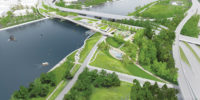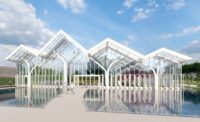The jury is still out on what kinds of infrastructure projects President Donald Trump means to build nationally. But New York governor Andrew Cuomo wasn’t waiting for Washington’s go-ahead when he announced the latest in a series of major infrastructure projects for the New York City area.
On January 4, the governor proposed spending $10 billion on an overhaul of one of the nation’s busiest airports, John F. Kennedy International. The plan calls for creating a single large terminal building. (Renderings, released by the governor, were created by Ricondo & Associates, an aviation consultancy based in Chicago; architects have yet to be chosen.) The airport’s older terminals, with the exception of Eero Saarinen’s landmarked TWA Flight Center, would be torn down or significantly altered. The new $8 billion terminal would be privately funded and—like a $4 billion HOK-designed terminal now under construction at LaGuardia Airport—would be run in part by public-private partnerships. The governor also plans to spend about $2 billion of public funds on improved road access to the airport.
But badly needed mass transit links to the airport are not part of the current plan, according to Rick Cotton, Special Counselor to the Governor for Interagency Initiatives. While Cuomo is committed to creating a direct link from Manhattan to JFK, “it’s not straightforward to accomplish,” said Cotton, who added that the governor has asked the Metropolitan Transportation Authority and the Port Authority of New York and New Jersey “to look at ways to improve getting to JFK by rail.”
Indeed, the unusual overlap of state and city governments with the two-state Port Authority makes it difficult for the governor to roll out infrastructure programs on his own. In January, the authority released a proposed 10-year capital plan that includes $3.5 billion for replacing the beleaguered Port Authority Bus Terminal in Manhattan, used by 230,000 commuters a day, but no design has been selected. Plans to improve nearby Penn Station, which services a total of 650,000 daily passengers, are just inching forward under the auspices of a complex roster of federal, state, and local agencies.
Building infrastructure isn’t always so complicated. For example, in Los Angeles, voters approved a sales-tax increase to fund $120 billion in transit improvements over the next four decades. The city’s expanded Metro Rail network will provide many Angelenos “one-seat rides” to Los Angeles International Airport, which is in the midst of a $14 billion renovation.
New York’s infrastructure is in “worse shape” than that of many comparable cities, including those in Europe and Asia, according to José A. Gómez-Ibáñez, the Derek C. Bok Professor of Urban Planning and Public Policy at Harvard’s Kennedy School of Government. Part of the reason is that much of New York’s transportation network is more than 100 years old, he says, and “replacing or rehabilitating existing facilities is traditionally thought to be politically less appealing than building new.”
Yet cities far older than New York are in the midst of dramatic infrastructure upgrades. In London, construction of the Crossrail system, a 73-mile east–west train line (26 miles of it through new tunnels deep beneath the city), is proceeding rapidly, with key sections expected to open late next year. And in Paris, work continues on a $28 billion metro line around the city, linking its outer suburbs, an initiative that The Atlantic called “the most ambitious new subway project in the Western world.”
But greater New York boasts two recent successes. One was the opening on January 1 of the Second Avenue Subway, a 2-mile-long line on Manhattan’s East Side—after nearly a century of planning and construction. Its four new stations—designed by AECOM and ARUP— are notable for their accessibility (elevators and escalators reach from street level to platforms) and their eye-catching public art, including works by Chuck Close and Vik Muniz. The other is the replacement of the 60-year-old Tappan Zee Bridge, which crosses the Hudson River 10 miles north of the city, with a new span scheduled to open in 2018— the year the governor runs for reelection. In the view of Gómez-Ibáñez, Cuomo’s “willingness to tackle some of the most important and expensive projects in New York’s backlog is unusual and encouraging.”






Post a comment to this article
Report Abusive Comment